The 2011 MacBook Air (11 & 13-inch): Thoroughly Reviewed
by Anand Lal Shimpi on July 28, 2011 3:25 AM EST- Posted in
- Apple
- Mac
- Intel
- Sandy Bridge
- MacBook Air
- Laptops
A New Thunderbolt Implementation
The other major change to the new MacBook Air is support for Intel's new Thunderbolt interface. We first met Thunderbolt on the 2011 MacBook Pro and saw it again on the iMac. Both the new Mac mini and the MacBook Air now support Thunderbolt as well, although the Air's implementation is slightly different.
If you look at iFixit's teardown of the new 13-inch MacBook Air you'll notice the absence of the traditional flip-chip Thunderbolt controller from the MacBook Pro, iMac and Mac mini. In fact, there are only two flip-chip parts on the motherboard - the Core i5 and the QS67 chipset.

13-inch MacBook Air (Mid 2011) Motherboard, QS67 (left), Intel Core i5 (right) - Courtesy iFixit
iFixit assumed that the QS67 chipset integrated Intel's Thunderbolt controller. Unfortunately there are a couple of things wrong with this assumption. First off, Intel has already announced that Thunderbolt wouldn't even be integrated in Ivy Bridge chipsets next year. While it's possible that Apple could request a special chipset from Intel, Apple would have to pay for the added design, manufacturing and validation costs or commit to huge volume numbers in order to make the effort worthwhile for Intel.
The second problem with the assumption has to do with the QS67 die itself. It looks unchanged from the square 6-series chipset die we saw back at CES earlier this year:
I didn't measure the two but they do look awfully similar. It's far more likely that the Thunderbolt controller is simply elsewhere on the motherboard. But where?
In all existing Thunderbolt Macs, the controller is very close to the Thunderbolt port. Looking carefully at the new MacBook Air you'll notice a tiny Intel chip near the Thunderbolt port:

Intel's Eagle Ridge SFF Thunderbolt Controller - Courtesy iFixit
This is a brand new Thunderbolt controller from Intel - codenamed Eagle Ridge. The chip used in the MacBook Pro, iMac and Mac mini is called Light Ridge and it looks like this:
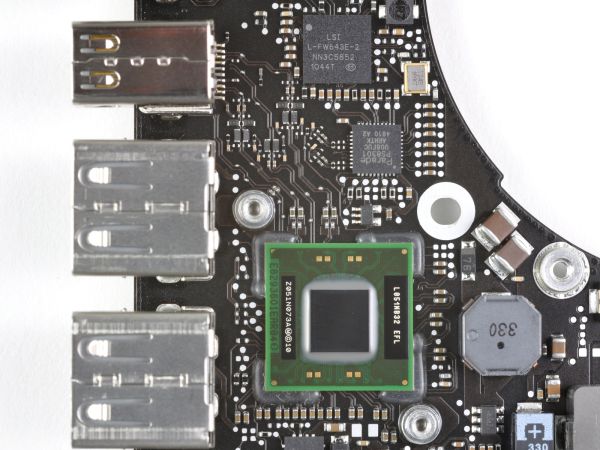
Light Ridge Thunderbolt Controller IC on 15" 2011 MacBook Pro - Courtesy iFixit
Light Ridge supports four bidirectional 10Gbps channels (20Gbps total per channel) channels and two DisplayPort inputs/outputs. On the iMac it's used to drive two ports on the back of the system.
Eagle Ridge is half of Light Ridge. You get two bidirectional 10Gbps channels (20Gbps total per channel) and one DisplayPort input/output. Eagle Ridge is offered in both a normal and small form factor package, the SFF version is what's used in the MacBook Air. I suspect Eagle Ridge is the cost reduced version of Intel's Thunderbolt controller Apple needed to maintain profit margins while bringing out a $999 MacBook Air with Thunderbolt.
Both the 11 and 13-inch MacBook Air have a single Thunderbolt port. This port is on the right side of both machines in the same location as the miniDP receptacle in last year's model.
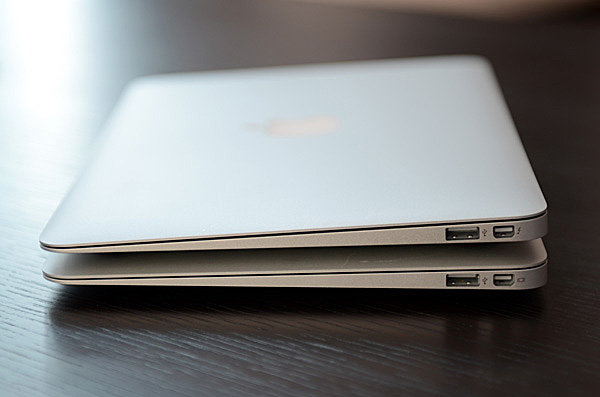
The Thunderbolt port on the new 11 (top)
I already mentioned that functionally Thunderbolt in the MacBook Air is no different than in the MacBook Pro. A quick visit to Windows 7's device manager confirms that the Thunderbolt controller branches off of the CPU's on-die PCIe controller:
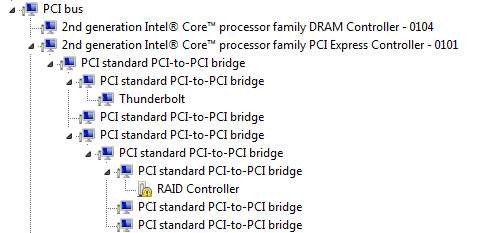
The unidentified RAID device is a Promise Pegasus R6, which still lacks driver support under Windows. With no discrete GPU in the MacBook Air there are more than enough PCIe lanes for Thunderbolt, but this controller still only uses (and needs) 4 of them.
Both DisplayPort and PCIe are carried over to the Thunderbolt port on the system. Apple clarified that you can in fact mix video and PCIe traffic on a single channel or across multiple channels. This gives you 20Gbps of upstream bandwidth and 20Gbps of downstream bandwidth to use however you want. Remember that driving a single 27-inch 25x14 display uses up around 7Gbps of upstream bandwidth alone, but there's still more than enough for storage and other needs.
I tested the Pegasus R6 with both MacBook Airs and its performance was similar to the MacBook Pro:
| Promise Pegasus R6 12TB (10TB RAID-5) Performance | ||||||
| Sequential Read | Sequential Write | 4KB Random Read (QD16) | 4KB Random Write (QD16) | |||
| 15-inch MacBook Pro (Early 2011) | 673.7 MB/s | 683.9 MB/s | 1.24 MB/s | 0.98 MB/s | ||
| 13-inch MacBook Air (Mid 2011) | 647.4 MB/s | 724.9 MB/s | 1.38 MB/s | 1.37 MB/s | ||
| 11-inch MacBook Air (Mid 2011) | 627.6 MB/s | 723.3 MB/s | 1.37 MB/s | 1.37 MB/s | ||
Write speeds were a bit higher but I suspect that has more to do with changes to performance under Lion than anything inherent in the hardware.
Thunderbolt devices appear under System Profiler the same way they do on the MacBook Pro:

The Thunderbolt port can also function as a miniDP output which works as expected on the Air. UI performance is ok on a 27-inch Cinema Display driven by a MacBook Air despite the lack of a dedicated high speed frame buffer. The biggest issue is that firing up Mission Control or swiping between Spaces is met with a significantly reduced frame rate. If you're going to be using a high resolution external panel regularly, you might want to consider a MacBook Pro with a lot of dedicated video memory.
Note that the Air can only drive a single external display. Not only does the Eagle Ridge Thunderbolt controller only support one DisplayPort output but Intel's HD 3000 GPU only supports two display outputs and one is already occupied by the Air's panel.
The Thunderbolt Display
Neither MacBook Air has an integrated Ethernet controller, there's no need as neither system is physically thick enough to accommodate a standard RJ45 connector. Apple has sold a USB 10/100 Ethernet dongle in the past for MacBook Air owners, but these days you can get better performance over good WiFi than you can from 100Mbps Ethernet. This is where that magical Thunderbolt port comes into play.
Remember Thunderbolt is just a carrier for PCI Express and DisplayPort. Any device that lives off of a PCIe bus can in theory be used over Thunderbolt. Typically your GigE controller is a PCIe device that resides on your motherboard. Sonnet took a PCIe Gigabit Ethernet controller, put it in a small box along with a Thunderbolt controller and built this:
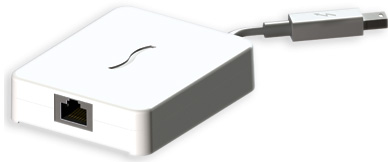
The Presto Gigabit Ethernet Thunderbolt Adapter is all you'd need to add GigE support to the MacBook Air. Need FireWire 800 support? Sonnet announced one of those too:
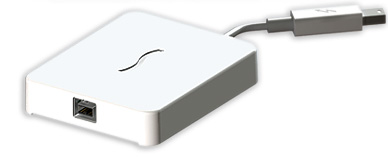
There's a total of 20Gbps of bandwidth in either direction over Thunderbolt, which is more than enough for 1Gbps of traffic over Ethernet or 800Mbps of traffic over Firewire. Availability is slated for "this summer" for both of these devices.
Rather than building individual cables, Apple did almost exactly what I asked for and built a monitor with more IO. It's called the Thunderbolt Display and it features an integrated USB 2.0, FireWire 800, Gigabit Ethernet and audio controller. All of these controllers reside on PCIe and are tunneled over to the host Mac via a single Thunderbolt cable.
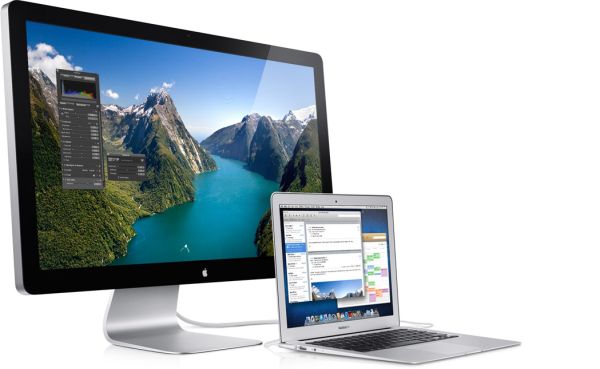
While the MacBook Air doesn't support FireWire 800 or Gigabit Ethernet, paired with a dongle, breakout box or Thunderbolt Display you can add those options presumably without giving up performance.
This is what Thunderbolt was meant to do. All we need now is widespread adoption, more accessories and a standard for external GPU form factors.


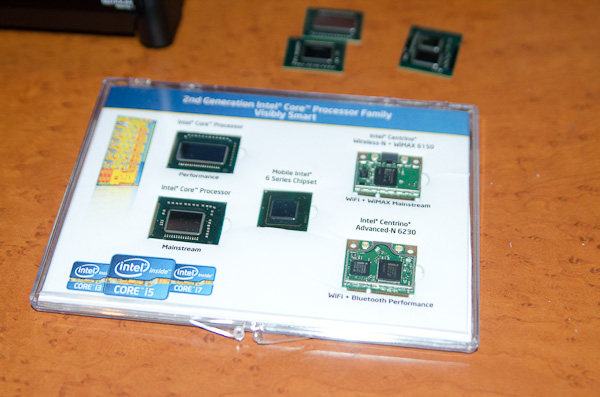








103 Comments
View All Comments
tipoo - Thursday, July 28, 2011 - link
I'd like to know too, in fact I think a decibel reading for laptop reviews would be great.solatic - Thursday, July 28, 2011 - link
"... [It's] easy to imagine a future where laptops become a lot more like the new Air and shift to a couple high bandwidth ports instead of numerous lower bandwidth connections."I agree in a sense, but I very much disagree with the manner of your idea.
Getting rid of low-bandwidth ports on laptops is stupid because these low-bandwidth ports are industry standards. The standard display jack for projectors everywhere, from business rooms to classrooms etc., is VGA. Good old VGA from the 90's which was never displaced by HDMI or DVI despite their ubiquity and technological superiority. Why is irrelevant, but my point is that I can't tell you how many people I've seen with Apple laptops who time and again have asked to borrow my machine with its VGA port because they can't find their VGA dongle or forgot it at home/the office.
VGA, RJ-45, USB - we don't use these jacks because of how much bandwidth they move but because we know we will encounter devices in the field that will use them.
What you really want, Anand, is a docking station. Lenovo/IBM has/did made/make them for some time for the Thinkpad line. You come to the office, slide your laptop in, and boom - the docking connector is a high bandwidth connector that connects you to network, display, audio, interface, etc.
The only real problem with docking stations is that they're either proprietary (the Thinkpad ones) or they're too slow for higher-bandwidth applications (USB docking stations). If you see a future in Thunderbolt docking station-type devices - like the Thunderbolt display - then this is a good thing. The Thunderbolt display can now be used by any Apple computer with a Thunderbolt port - whereas Lenovo has to manufacture different docking stations for the X and T series and these docking stations can't be used with Toshibas, Apples, Dells, etc.
But to propose getting rid of VGA and RJ-45 ports now is not something I can agree with. Put Thunderbolt on new machines, make Thunderbolt projectors etc., wait for them to saturate the market - and then, only then, does it really make sense to get rid of these slower ports.
repoman27 - Friday, July 29, 2011 - link
It certainly makes sense to ditch VGA on a product like the MacBook Air, since a VGA port is too large to physically fit inside it. And it makes sense on all other laptops since most people would rather have 10 more mins of battery life all the time than a VGA port on the odd occasion that they need one. I propose that those who own archaic video devices lacking a digital interface buy a $5 adapter and leave it attached to the device, that way people with modern notebooks can connect to them without issue.The lack of a wired Ethernet port on the Airs is also due to its ultra slim profile, but it amazes me how many people I know that have no idea that they can plug their laptops into a wired network and get far better throughput. As long as WiFi offers more bandwidth than most people's ISPs, I think you can kiss that RJ45 port goodbye without upsetting too many folks.
Wolfpup - Thursday, July 28, 2011 - link
Great reviews like this are why I love this site. Super thorough and interesting on the tech, and, interesting thoughts on practical stuff too.I prefer Windows, but have been wanting a secondary Mac for a while for the heck of it. I'm SUPER torn on what to get...
The 11.6" almost seems perfect, since I can throw it in my bag with my main notebook and be okay-stick it on my desk without too much issue. But...if I ever actually used it as my primary system, the 13.3" one would be a lot more usable. And at THAT point, the 13.3" Pro is a lot more usable, and at THAT point, the 15.4" Pro isn't much larger, and completely destroys it, and of course could be my main system...
Sooooo you see my dilemma ;)
Heh...maybe I should just go with the 11 since I'm not planning on using it as my primary.
name99 - Thursday, July 28, 2011 - link
"All three parts support Hyper Threading and Quick Sync, although the latter remains mostly unused in OS X. "Quick Sync is used by iChat HD, is it not?
The other natural client for it would be AirPlay. My guess is that, come iOS5 in September, we will see AirPlay on SNB macs beefed up to be able to stream any content (not just h264) to AirPlay devices by doing the transcode transparently on Quick Sync.
The third obvious sort of client would be a library that third party apps like HandBrake would get to. What's the currents situation now --- do you need to be root to get to QuickSync or can any app use it?
My guess is that we are facing the constant problem of new "weird" hardware --- it never comes virtualizable in the first iteration, which means that there is ALWAYS the problem of how to mediate access. And we generally see the same pattern
(a) A single app that is allowed access.
(b) Some sort of library that provides its own mechanisms for mediating access.
(c) The hardware (FINALLY) becomes virtualizable.
Apple is currently at step (a). Getting to (b) is never completely trivial (in spite of the claims of no-nothings in blog comments), at least if you want to do the job properly. You have to consider questions like --- do you use a reservation model, or do you simply provide notifications when you want to grab the hardware away from a user? How easy is it juggle state and provide something that looks virtualized? etc etc.
And there are ALWAYS, at least in the first gen, weird hardware interlocks that make life more difficult. I know nothing about QuickSync but I would not be surprised if, for example, using it has implications for using the main GPU, meaning one more thing that has to be balanced in the attempt to make it used more generally.
Can someone from the Windows world (who understands these issues, and has something more useful to say than "Macs suck") tell us how QuickSync is used in the MS world? Does MS provide a general purpose library, and how does the mediation model for that library work?
name99 - Thursday, July 28, 2011 - link
Oops, my bad. The Macbook Airs apparently do not have an HD camera because it can't fit in the available depth of the thin screen. So no iChat HD on these models.I think the rest of what I said, especially about AirPlay, still stands.
rootheday - Friday, July 29, 2011 - link
The sharing/scheduling of the GPU enginers by multiple client applications on Windows is mediated by the OS as part of the WDDM driver model dating back to Windows Vista - QuickSync is no exception. This means that we are already at c) on your hierarchy on Windows with multiple client applications able to easily share the GPU for encoding.Moreover, Intel has a library already for this - see http://software.intel.com/en-us/articles/media/
The media sdk library provides an API that applications can use to perform encoding and decoding. If run on a system with QuickSync hardware support and drivers, the work is routed to the GPU. If not, the library offers a CPU fall back path. This allows ISVs to write their application once - it will just run faster on Sandybridge systems.
I don't know enough about Apple OS and graphics driver model to comment on how hard it would be for Apple to get to the same level.
jvmxtra - Thursday, July 28, 2011 - link
Thanks for the great review. I throughly enjoyed your review but I feel like one thing is missing.In fact, for a laptop review, I really want all the sites to start devoting some time and even creating a method to measure the heat that laptop brings on. We have to create some type of way to measure(benchmark?) the heat index as I feel like how hot laptop gets under certain circumstance is critical factor.
In fact, I had to trade in my 15 inch mbp since it was just getting too hot.
tipoo - Thursday, July 28, 2011 - link
The thermals and power consumption page is a start.name99 - Thursday, July 28, 2011 - link
"This is what Thunderbolt was meant to do. All we need now is widespread adoption, more accessories and a standard for external GPU form factors."AND device manufacturers who are not idiots. In particular, where are the TB hubs?
The device the market obviously wants is a TB to USB3 hub ---
two TB ports, four USB3 ports --- and yet we still have not seen this.
I'm sorry, Sonnet, but this would be VASTLY more useful than your EN and FW800 bridges.
WTF is going on?